M-50. Looking to the future
Remember, in the film “Barrier of the Unknown”, the motive of which was inspired by the events and views of the early 1950s, a small hypothetical plane, suspended under the seemingly giant Tu-16, launched at a high altitude and overcome invisible obstacles. This idea was put in the first version of the project "50". The proposal to create such a machine, approved by the State Committee for aviation equipment and the customer, and did not lie in the government. In July 1954, a resolution of the Council of Ministers was issued, which allowed to launch large-scale work on the "Remote Long-Range Bomber", consisting of a strike aircraft and carrier with four turbojet engines. In fairness, I note that a similar idea among Soviet aviation specialists was so popular that other design bureaus also worked on it.
According to the task, the "50-th" had to reach speeds of up to 1800 km / h with a cruising -1500-1600 km / h at altitudes of 14-15 km. The practical range of the system with a bomb load of 5000 kg was estimated at 13000 km. It took about a year to prepare a draft project, but in the summer of 1955, the direction of work on the topic "50" changed dramatically. Now a “clean” long-range bomber with increased cruising speed, designed for four bypass engines NK-6 or TRD VD-9, was required. March 1956-th government decree has already provided for the installation of TRD M16-17. OKB-23 made every effort to select the optimal aerodynamic layout of the aircraft. In TsAGI wind tunnels, 39 of various models was tested, and the weft of the scale of the weights was clearly outweighed. Taking this opportunity, I want to explain what a "duck" is. Another reader may grin while doing so, but have patience.
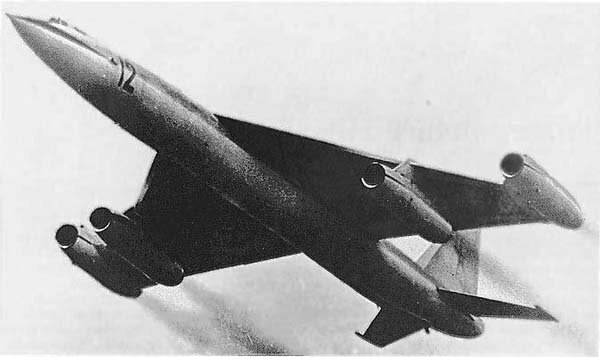
Today, the "duck" is called all the aircraft in a row, barely finding on them the front horizontal tail, but it is not. Historically, this term hides an aircraft with front horizontal tail, equipped with a rudder. Unfortunately, they forget about this to explain to students of aviation universities. As a result, not only in periodicals, but also in special documents, “newspaper ducks” appear - airplanes, in which the front horizontal tail serves either to improve takeoff and landing characteristics, or to balance the vehicle. In this case, the control in the pitch channel is carried out with the help of elevons.
The “duck” scheme of aerodynamics is considered to be one of the most difficult, and therefore the OKB-23 spent about a year on its preliminary testing. This is a huge period of disputes, the manufacture of models, the queues in the wind tunnels and, finally, the analysis of the materials obtained. It seemed that the final appearance of the car had matured, but the designers stopped at the classical scheme with a triangular wing in plan of relative thickness 3,5%. The reason here is not in some traditions or inertia of thinking, but in the unwillingness of the TsAGI leadership to deal with this problem. This is not my notion, documents testify to this. At the suggestion of V.A. Fedotov, who once headed the company, and Yu.E.Ilyenko, two engines were placed on pylons under the wing, and two - at the ends of the wing.
When creating a new car, there are always a lot of questions that require research and development to answer. The creators of M-50, having no analogues, tried to combine the seemingly incompatible. With the high specific costs of the turbojet engines of those years, it was necessary to ensure not only high supersonic speed, but also a huge range. To make plans become a reality, the designers decided to reduce the crew to two people, leaving the pilot and co-driver located in the cockpit with armored protection. Crew jobs were one after another, according to the tandem scheme, and landing and ejection (in the fashion of those years) were carried out through hatches in the lower part of the fuselage.
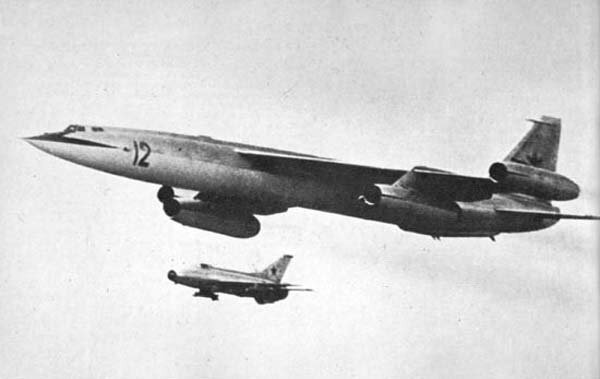
To solve all the problems that arose during the flight, it was necessary to fully automate the aircraft and its control, in fact, placing control over the flight for two people. Hydromechanical control was used as a backup in which the translational movements of the steering column and pedals were turned into rotational movements and transmitted through high-speed shafts driven from the hydraulic motor to the steering and aileron actuators. If necessary, it was planned to switch to manual control at any stage or flight mode. Apparently, for the first time in the world, an electric remote system with triple redundancy was used to control the engines. To make a bet on automation meant that with the existing element base all the benefits from it would be reduced to nothing by the mass of equipment and power sources. To get out of the vicious circle, the electronic industry was tasked with accelerating the work on miniaturization of equipment. The airplanes, in turn, proposed to use alternating three-phase alternators on an aircraft instead of traditional sources of direct current.
On the plane appeared, to put it in modern language, flight-navigation complex. The equipment consisted of three radio stations: the connected “Planet”, the command RSYU-3M and the emergency “Kedr-S”. In addition, there were: SPU-6 intercom, high and low altitude radio-meters RT-5 and PB-25, interrogator-responder SRZO-2, tail station "Sirena-2" and much more.
The future M-50 was calculated for flights in the range of speeds from landing 270 km / h to 2000 km / h at altitudes up to 16000 m at a distance (with refueling in flight) to 15000 km. The maximum take-off weight of the aircraft at the start with accelerators reached 253 t, of which the fuel accounted for 170 t. During the flight, at least two refueling operations could be performed, the first of which was planned at a distance of 2000 km from the departure aerodrome. In this case, in all modes it was required to ensure a stable and controlled flight. As a result, a whirlwind tail appeared.
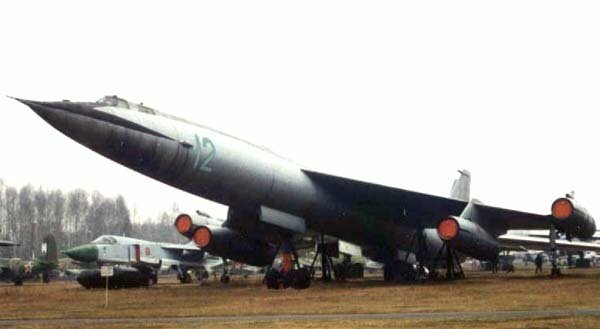
Who is familiar with aerodynamics, he knows that when moving from subsonic speeds to supersonic, the center of pressure of the aerodynamic forces of the wing shifts towards the tail. This effect, which often led to the catastrophes of the first jet planes, forced us to look for new ways to preserve the required longitudinal stability margin. Thus, a proposal appeared to change, depending on the flight mode, the position of the center of gravity of the aircraft by pumping fuel from one group of tanks to another. This technical solution, applied for the first time on the M-50, subsequently found widespread use on supersonic machines, including the Tu-144 and the Concorde.
“While working on the M-50 project,” LL Selyakov said, “solving the complex tasks of creating fully automatic flight control systems on an almost“ neutral ”aircraft, I insisted on the incompatibility of large, cumbersome control levers, which is the traditional steering wheel with fully automatic system. I proposed to create a control unit with a handle similar to the existing autopilot handle, with which the navigator turns the plane to the target. The requirements of TsAGI strictly on compliance with regulations on the efforts and strokes per unit overload when creating automatic control systems are completely unnecessary and harmful. Unfortunately, TsAGI prevailed, Myasischev Rodnyanskiy and did not support me, and Absu-50 system complied with classic arms and demanded efforts ...
For the first time in the USSR, the M-50 used an automatic system for regulating the position of the center of gravity in flight by pumping fuel between the fuselage and wing groups of the caisson-tanks. The need for this has arisen because during the transition to supersonic speed, the character of the flow around the wing changes, and its center of pressure (the conditional point of application of the resulting lifting force) shifts backwards, leading to the appearance of a diving moment. Without fuel transfer, the compensation of the dive moment would require an increase in the size of the horizontal tail and, accordingly, would lead to an increase in aircraft mass and aerodynamic drag. The author of the decision was L. Minkin. Also for the first time in domestic practice at M-50, by using the achievements of radio electronics, the crew of a heavy bomber was reduced to two people. The pilot and navigator sat one by one in the nose of the fuselage. Innovations have saved several tons of take-off weight of the aircraft, limiting its 210000 kg.
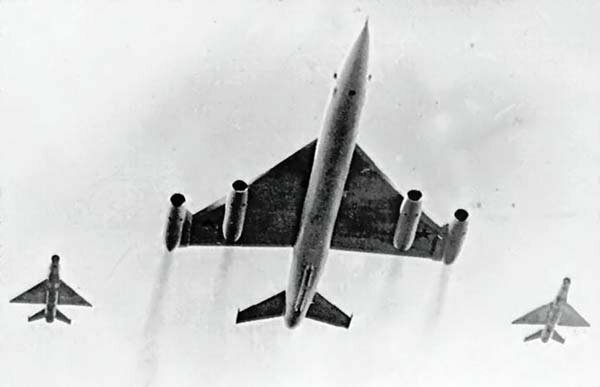
The lack of practical experience in piloting aircraft with a delta wing led to the creation of an analog simulator, in which test pilots familiarized themselves with the control of the future car, while learning how to fly it.
Creation of the first in the USSR automatic on-board control system, including a device for maintaining a specified longitudinal stability stock by tracking the aerodynamic focus offset of the center of gravity position (fuel transfer system proposed by L.Z. Minkin), taking into account the instantaneous change in centering (when special loads are dropped), deformation , changes in the speed and altitude of the flight, proved to be the most difficult thing. Initially it was assumed that the area of the controlled stabilizer would not exceed 5% of the wing area. It was believed that, since the stability margin is small, then the required control points will be small. Everyone was hoping for an in-flight fuel transfer system.
However, it soon became clear that in the event of a failure of the artificial centering device, the aircraft in a number of modes falls into the region of instability. The landing of the "fifty" in this case was decisive, and the area of the horizontal tail was doubled. The use of the whirlwind keel helped to reduce its area, weight, aerodynamic resistance and improve the behavior of the machine during takeoff and landing modes with side wind. "Despite all the measures taken to reduce the weight of the airframe, the production workers did not meet the prescribed limits on 18 T. The application of the skin panels for the first time in the domestic practice, followed by milling, was a little helpful. The manufacturing technology of many elements was only mastered and failed tionary, some of them weighing four tons had to be produced from billets weighing 40 t. All these costs increase the weight of the car.
On the M-50, they abandoned the supplementary tanks and the fuel was poured into the sealed compartments of the fuselage and wing. Used and previously proven technical solutions. This is a bicycle chassis with a billowing front carriage, which made it possible to make a gap at attack angles larger than at the beginning of the run, slotted flaps and much more, previously tested on the M-4 and 3M. To reduce the mileage after landing provided brake skis. Initially, the aircraft was created as a means of delivering air bombs, but already during the design it tried to suspend cruise missiles, in particular, the 45B planning missile, which was developed by the Design Bureau. In 1958, AD Nadiradze proposed launching ballistic missiles with M-50. Special attention was paid to engines. After all, it largely depended on them whether the plane would reach a given speed and design range. It was very important that the specific fuel consumption during cruising does not exceed 1,12 kg / kg.h. Only in this case it was possible to get the specified range.

M-50 was originally calculated under four turbofan NK-6 or TRD VD-9A, and then they were replaced by another Council of Ministers decision on the engines of the MFNUMX-16 (РД17-16) engines. By the beginning of the 17, the NK-1961 was the most powerful Soviet TRDDF. With a dry weight of 6 kg, it was originally calculated for the afterburning thrust of 3500 kgf. The high temperature characteristics of gases in front of the turbine to 22000¦К contributed to the high performance. In November, 1130-th at the stand received 1960 kgf thrust with specific fuel consumption during the 22400 afterburner kg / kg.h. However, it soon became clear that to ensure the 1,72-hour resource, it was necessary to reduce the afterburner thrust to 50 kg, and the maximum - to 19000 kg.
In December, 1955-th customer presented a preliminary design of the machine, and by May next year, built a layout. The mockup commission worked for almost a month. Its chairman was Marshal of Aviation V.A. Sudets. The results of the commission were unexpected for designers. In her opinion, she noted, in particular: "... obtaining a given (...) 11000-12000 km range at a cruising speed of 1700-1800 km / h without in-flight refueling is not ensured. The specified maximum practical range (... ) with two refueling in the air is provided within 14000-14500km, while performing refueling at subsonic speeds and the presence of overhead tanks on the aircraft leads to the need to fly at the initial 3000 km distance not only at relatively low speed, but also at altitudes superior xnumx m which is unacceptable, as in these conditions the plane can be relatively easily intercepted by enemy air defense ... The length of the take-off of an 8000 plane, given by the USSR Council of Ministers decision, is not performed without starting accelerators ... To operate an aircraft from existing aerodromes the starting accelerators are no more than 3000 m. Offered by the OKB-2500 MAP are other ways of taking off the plane: a point start, taking off from the hydrocart - are of interest to the Air Force as more economical and provide s best combat aircraft dispersal of strategic aviation. These new take-off methods require detailed constructive study and verification of flight tests. Air Force requirements for the defense of the OKB-23 MAP are not met ... Thus (...) the layout of the 23 cannot be approved. "
In this regard, a meeting was held at MAP with the participation of specialists from various research institutes. According to his results in February 1956, P.V. Dementyev wrote to the Commander-in-Chief of the Air Force P.F. Zhigarev: “As a result of an exchange of views, MAP cannot agree with the deviation of the draft design and layout of this aircraft, since the creation of a long-range supersonic bomber with a cruising speed of 1700 -1800 km / h is an extraordinary task ... From this point of view, the basic requirements for the 50 aircraft should be approached. It is technically quite clear that the task of obtaining a long-range XSUMX t bomber at supersonic speeds by increasing the takeoff length, so when setting the 265 m take-off distance for this aircraft, accelerators must be used.We believe that for M-3000 the principle of defense should be radically changed, since the installation of conventional weapons only leads to weight gain the aircraft, the deterioration of its aerodynamics, and consequently, the reduction of the flight range, therefore, the aircraft’s defensive system must consist of radio resistance to repel attacks of fighters and missiles ... OT "50" without refueling (..) is really below the target (...), but the total - with two gas stations provides the specified 50-14000 km ... I ask you to revise the conclusion of the Air Force according to the draft design (...), so MAP does not find any other ways to create such an aircraft in these terms. "
In the autumn, the model was approved, however, the engines did not appear. In order not to waste time on the prototype, which received the M-50A index, the TRD VD-7 was set with a weight of 11000 kgf. The "race" of engines and ground testing of all aircraft systems began in the summer of the 1959-th at the factory airfield, and in the autumn M-50A was transported to the fine-tuning base of the OKB.
In 1958, the decision is made to exempt OKB-23 from presenting M-50 for state tests and to use two M-50 under construction with VD-7 and M16-17 engines for testing the future M-52. Around the same time, the Fifty-dozen tanker project was proposed for refueling the combat vehicle at supersonic speeds and heights of at least 10000 m. The M-50 developed the M-50LL flying laboratory for research of the turbofan engines created based on the NK-12 TVD and the TS-12M turbo starter, and the M-51 unmanned carrier for the delivery of a nuclear weapon. In May, the 1959 began the taxiing of the bomber.
October 27 1959, piloted by Nikolai Iosifovich Goryainov, the prototype M-50A took off from the airfield of the Gromov Flight Research Institute. Since at the time of the beginning of the test, the teeth of the Jag design had not yet been brought in, then four less powerful VD-7 motors (9750 kgf) of the Dobrynin design were installed on the prototype. To increase the thrust to 14000 kgf, two underwing engines were equipped with afterburners. However, this did not help: M-50 never surpassed the speed of sound, Loops in M = 0,99. In addition to this failure and one minor accident, other tests of the aircraft, conducted by N. Goryainov and A. Lipko, went smoothly. A somewhat excessive efficiency of whole-pivot vertical tail was revealed.
During the flight tests, the take-off weight of the car apparently did not exceed 115 t, which is explained by the slight engine thrust. M-50A made eighteen test flights, when in 1960-m they decided to discontinue work on it and on the M-52 built by that time, which was, in fact, a modification of its predecessor. There are several reasons for this, but the main ones are the discrepancy between the characteristics of the aircraft set by the Council of Ministers resolution, and, of course, the policy aimed, in fact, at lowering the role of the Air Force in modern warfare. On the test plane was not without trouble. During one of the "races" of the engines, M-50A broke from the brakes, and crashed into the 3M standing in front of him, taking the life of the radio operator Kruchinin. There is a case when the fuel pipeline burst in flight. Kerosene poured a powerful stream on the hot engine nodes and only by happy coincidence there was no fire. In general, according to the veteran of the OKB-23 S.А. Shirokopoyas, the flights on the M-50А required the crew to mobilize all their human capabilities and bordered on the feat.
At the end of May 1961, after the liquidation of OKB-23, the decision was made to demonstrate the M-50 at the air parade in Tushino. The plane, which had been standing on the ground for almost a year, was prepared for an exemplary flight by a team led by Ya.B.Nodelman. The pilots N.I. Goryainov and A.S.Lipko, after four training flights, 9 July showed the machine to the public, putting an end not only in its history, but also in the activities of OKB-23. During the tests, the aircraft had the tail number L023¦, however, before the first public demonstration, the number was changed to L12¦. Above the airfield Tushino M-50, piloted by H Goryainov, accompanied by two MiG-21 made a spectacular flight. In the West, the plane made an impression, it was assigned a NATO code Bounder, and even talked about serial production. But at that time, in the fall of 1960, VM Myasishchev was appointed head of TsAGI, and OKB-23 was disbanded. The team was reassigned to VN Chelomey, who created the space technology, and M-50 was subsequently transferred to the museum in Monino. The collapse of the company did not allow the built aircraft to be completed and the projects to be completed. The widespread enthusiasm for ballistic missiles seemed to put an end to strategic aviation.
But before the OKB was disbanded, the work on the bombers was in full swing. Immediately after the M-50, the design of its modification M-52 began, on which the underwing engine nacelles were installed at a significant angle to the plane of the wing, while the outer ones had slightly different pylons. M-52 installed additional horizontal tail at the top of the keel, carried out internal modifications It was supposed to install the system refueling in the air. The armament consisted of four air-to-ground missiles. The first copy of the M-52, equipped with L16-17¦ engines, was built, but not tested and scrapped.
Only on paper and in models did the M-54 project exist. From the M-50 it differed wing with a small sweep on the trailing edge. It also analyzed various options for the location of the engine nacelles.
The X-NUMX g completed the design of the strategic bomber M-1960, with a cruising speed within M = 56-2,5, with a range up to 3,25 km and a take-off weight of about 10000 t. It had an aerodynamic layout of Lutka with two vertical fenders. But it was not the usual Lutka¦. At subsonic speeds, the front horizontal tail was freely orienting and did not affect the stability characteristics. In this configuration, the aircraft actually had an aerodynamic configuration of the "tailless". When switching to supersonic speeds, the horizontal plumage was recorded. This ensured the longitudinal stability of the machine when changing the distribution of aerodynamic forces on the wing. This decision made it possible to abandon the complex fuel transfer system.
At the beginning, the M-56 had a lot in common with its predecessors: a delta wing and four engines in separate nacelles. However, he soon received developed flows between the wing and the fuselage, and six engines were placed in a single package under the wing. Built a full-size M-56 layout. In parallel with the work on the aircraft in the Design Bureau V.Ya. Klimov were working on the engine VK-15.
On the basis of the M-56, its passenger version of the M-55 was worked out, in sub-versions of the M-55А, M-55Б and M-55В, differing in size and number of engines. The first of these was designed for 40 passengers, the second for -85, and the third for -120. M-55A had two engines, M-55B - four, and M-55B - six.
At the end of 50's In the aviation press (for example, in Aviation Week from 1 December 1958), hypothetical drawings of a Soviet bomber with a nuclear power plant, outwardly very similar to the M-50, appeared. Most likely, Western experts compared information on M-50 with the topic of nuclear aircraft engines, which was fashionable at the time. Meanwhile, the Myasishchev Design Bureau under the code M-60 was actually being developed, an aircraft with a nuclear power plant, which was designed by the OKB AM. Cradles. This machine has not gone beyond the project stage.

There was another almost incredible project - a strategic bomber-flying boat M-70. This plane, splashing down at a given point in the ocean, could replenish the fuel from the surfaced submarine and continue its journey. Very reminiscent of the M-50, he, however, had a fuselage-boat and the location of four engines, excluding the ingress of splashing into them.
In the middle of 60's. The leadership of the Air Force realized that the rush to wind up the flight program was premature. Strategic bombers proved to be more flexible weaponsthan intercontinental rockets. An aircraft equipped with cruise missiles, patrolling right at the borders of the enemy, ensures that the target is hit in far less time and more likely than a ballistic missile, which needs to be overcome by almost fifteen hundred thousand kilometers in an increasingly sophisticated anti-missile defense. In the end, even in local conflicts, the power of strategic aviation can be used when mine rockets are simply useless. In the second half of the 60's. the question of replacing the Tu-95, M-4 and ZM arose with a new sharpness, and this led to the next revival of the Myasishchev OKB.
In 1967, the military put forward the following tactical and technical requirements: range 11000 - 13000 km when flying at subsonic speeds at low altitude; the same range when flying at a speed of 3200 - 3500 km / h at an altitude above 18000 m; 16000 range -18000 km when flying at a speed of 800 - 900 km / h at an altitude of 10000 m.
In response to 1967-68. there was a project M-20. There were several options: one - according to the scheme Lutka¦ with a triangular wing, the second - Lutka¦ with a wing of variable geometry, the third outwardly resembled the Tu-160, there were other options All of them were created for engines with a variable bypass ratio developed by the Kuznetsov design bureau . The main competitor of the M-20 was the T-4MS developed by the Design Bureau P.O. Sukhoi (about him? In the second part of the article). During the competition it turned out that it was impossible to meet all tactical and technical requirements. I think that today they are unattainable. The Air Force revised them and at the new stage the struggle broke out between Myshischevsky M-18 and Tupolev Tu-160, and the Sukhoi design bureau turned the work on strategic aviation. The outcome of this competition is known for sure: the Tu-160 was built, tested and put into service, and the M-18 remained on paper ...
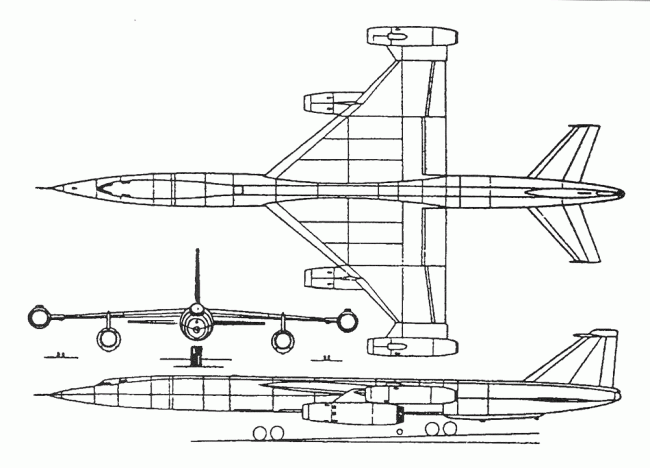
Information